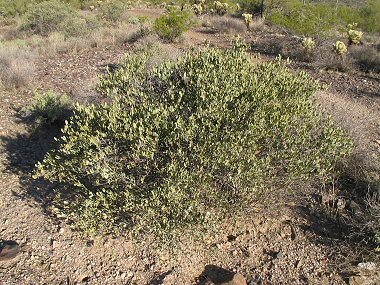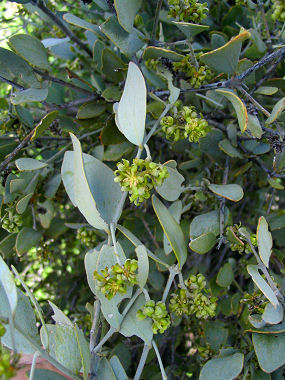Jojoba (pronounced hoe-HOE-buh) is a
member of the Box Fami ly.
It appears as a woody evergreen shrub which grows from 2-5 feet in
height. It has thick, leathery, grayish green leaves which are
elliptical in shape and grow to 1.5 inches in length. It typically grows
along washes and on dry rocky slopes at elevations between 1000 - 5000
feet. The plant blooms between December - July and produces small
greenish yellow flowers which grow in dense clusters. Flowers are
followed by a green acorn-like nut which grows to 1.5 inches in length.
The plants are typically pollinated by the wind. ly.
It appears as a woody evergreen shrub which grows from 2-5 feet in
height. It has thick, leathery, grayish green leaves which are
elliptical in shape and grow to 1.5 inches in length. It typically grows
along washes and on dry rocky slopes at elevations between 1000 - 5000
feet. The plant blooms between December - July and produces small
greenish yellow flowers which grow in dense clusters. Flowers are
followed by a green acorn-like nut which grows to 1.5 inches in length.
The plants are typically pollinated by the wind.
|
A single jojoba will typically
produce more than 2 pounds of pollen each year. Fortunately few
people are allergic to it. |
Jojobas are draught deciduous, which means they will
shed their leaves in response to draught conditions. Leaves of the plant
are browsed by deer, javalina and bighorn sheep while the nuts are eaten
by small rodents and birds. The nuts contain a high percentage of a waxy
oil which is used in some commercial applications including medicines
and cosmetics. The plant is also commonly used as a landscape plant.
|

